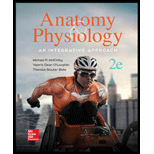
a.
To determine:
If both stroke volume and heart rate increases, cardiac output (a) stays the same, (b) increases, or (c) decreases and to determine whether the relationship between these two variables and cardiac output is inverse or direct.
Concept introduction:
The amount of blood, which is pumped by either ventricle in one minute, is known as “cardiac output” (
To determine:
When both stroke volume and heart rate increases, cardiac output stays the same or not.
b.
To determine:
When both stroke volume and heart rate increases, cardiac output increases or not.
c.
To determine:
When both stroke volume and heart rate increases, cardiac output decreases or not.
Want to see the full answer?
Check out a sample textbook solution
Chapter 19 Solutions
Anatomy & Physiology: An Integrative Approach
 Human Physiology: From Cells to Systems (MindTap ...BiologyISBN:9781285866932Author:Lauralee SherwoodPublisher:Cengage Learning
Human Physiology: From Cells to Systems (MindTap ...BiologyISBN:9781285866932Author:Lauralee SherwoodPublisher:Cengage Learning Medical Terminology for Health Professions, Spira...Health & NutritionISBN:9781305634350Author:Ann Ehrlich, Carol L. Schroeder, Laura Ehrlich, Katrina A. SchroederPublisher:Cengage Learning
Medical Terminology for Health Professions, Spira...Health & NutritionISBN:9781305634350Author:Ann Ehrlich, Carol L. Schroeder, Laura Ehrlich, Katrina A. SchroederPublisher:Cengage Learning- Basic Clinical Lab Competencies for Respiratory C...NursingISBN:9781285244662Author:WhitePublisher:Cengage



